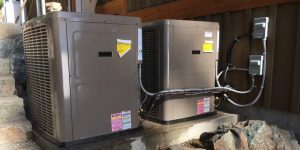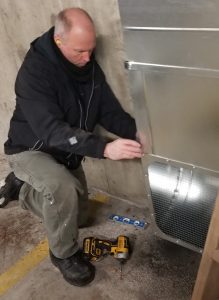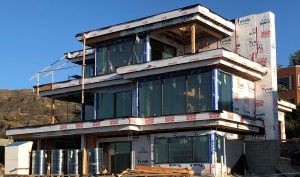Langford-Based Company Specializes In Heat Pumps, HRV And Ventilation Service

Residential heat pump systems and ducting
LANGFORD – BR Ventilation Ltd. helps buildings – and customers – breathe easier.
Company founder and owner Bill Simons says the company provides commercial and residential sheet metal, heat pumps, HRV and ventilation system service throughout Greater Victoria from Sidney to Sooke, as well as Mill Bay and the Cowichan Valley.
“I started the company part time in 2003, and went full time in 2009,” Simons notes. “I work out of our shop and office on Leigh Road in Langford, and am responsible for running the company on a daily basis, organizing staff, estimating jobs, and various paperwork items.”

BR Ventilation Ltd. owner Bill Simons on the job
Simons adds: “We provide many services to help with heating and cooling needs. Whether it’s a renovation or new building, we can custom build a ventilation system to accommodate whatever heating system is needed.”
All of the company’s employees are certified journeyman and registered apprentices, and the company is TECA Certified, Quality First Approved, and WCB Insured. BR Ventilation can service Carrier, Trane, American Standard, Air Ease, Mitsubishi, Fujitsu and Daiken products.
“Recently we have been installing many slim-ducted and Red Zone hydronic systems, due to the smaller footprint these systems have in residential homes,” he adds.
BR Ventilation provides supply and install of HVAC products for institutional, commercial and industrial buildings. From the beginning of a project to completion, it’s handled by BR Ventilation employees, and the company has its own delivery service for materials to the job sites to ensure time and efficiency. Their team is also able to provide made to order
Heat recovery ventilators (HRV) and energy recovery ventilators (ERV) are air exchange systems that help to enhance indoor air quality and minimize heating costs, and Simons says the demand for both is high.

BR Ventilation builds custom HRV systems for customers
“They retain existing heat and optimize the interior moisture content in the air,” he notes. “These mechanical systems use fans to maintain a balanced airflow into the house while exhausting stale indoor air.”
There are some differences between the two, as HRVs and ERVs are similar devices that supply air to the home and exhaust stale air while recovering energy from the exhaust air in the process. They also both offer operating cost savings for customers.
“The primary difference between the two is that an HRV transfers heat while an ERV transfers both heat and moisture,” he states. “Both ventilation systems place the control of air quality and air exchange in the hands of the homeowner rather than relying on inherent, often inadequate, leaks in the home to provide necessary ventilation.”
Simons is thankful that the company has managed to keep busy and steady during COVID-19, and attributes the company’s success to “Having good people and the willingness to work with our customers and steady clients.”
This story was sponsored by:
EMCO HVAC (Silver) & EH Price (Bronze)


